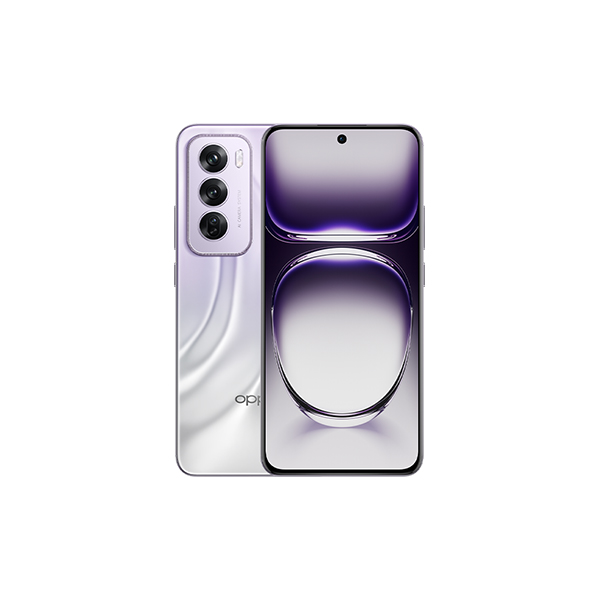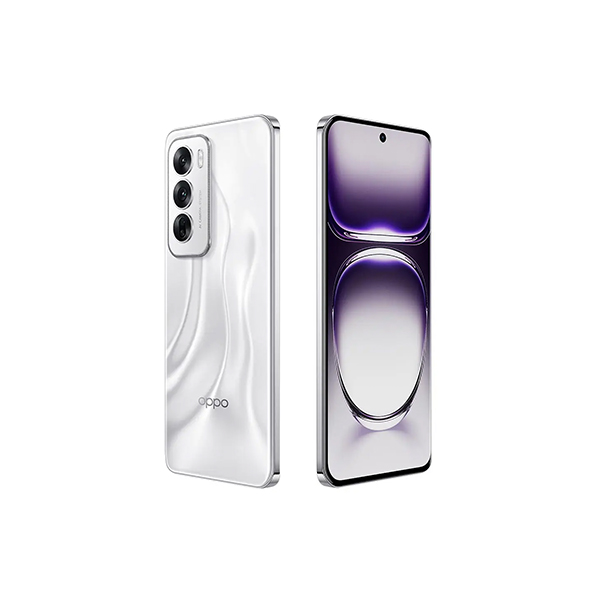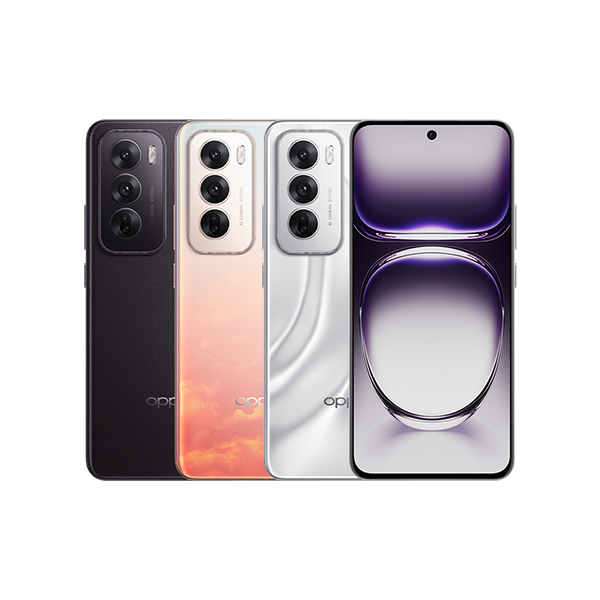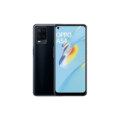Oppo Reno 12




Specs
General
| Device Type | Oppo phone |
| Announced | 18 June, 2024 |
| Released | 20 June, 2024 |
| Status | Available |
Design
| Dimensions | 161.4 x 74.1 x 7.6 mm |
| Weight | 177 g |
| Protection | Glass front (Gorilla Glass 7i), plastic frame, plastic back |
| Colors | Matte Brown, Sunset Pink, Astro Silver |
Display
| Refresh Rate | 120 Hz |
| Display Type Display Technology => A number of display technologies and types used in mobile phones => TFT (Thin Film Transistor), IPS (In-Place Switching), OLED (Organic Light Emitting Diode), AMOLED (Active-Matrix Organic Light-Emitting Diode), Super AMOLED (an even advanced version of AMOLED), Resistive Touchscreen (Resistive touchscreens contain two layer of conductive material with a very small gap between them which acts as a resistance), Capacitive Touchsceen (Capacitive touchscreen technology consists of a layer of glass coated with a transparent conductor) | Flexible AMOLED |
| Size | 6.7 inches (17.02 cm) |
| Resolution | 1080x2412 px (FHD+) |
| Display Colors Display Colors is refers to the number of different shades of colors that the screen is capable of displaying => 64K colors, 256K colors and 16 million colors, Obviously 16M is highest available range of colors and better than others. | 1 B |
| Pixel Density Pixel Density (PPI) is refers to the concentration of pixels on a particular display, measured in pixels per inch (ppi). Pixel density is calculated by dividing the diagonal pixel resolution of a display by its diagonal size, higher pixel density better display quality. | 394 ppi |
| Touch Screen | Capacitive Touchscreen, Multi-touch |
| Display Protection Display Protection => Gorilla Glass is a special alkali-aluminosilicate glass shield with exceptional damage resistance that helps protect mobile displays from scratches, drops, and bumps of everyday use, It is always better to go for a smartphone with Gorilla Glass for that added protection and peace of mind. | Corning Gorilla Glass 7i |
| Features | HDR10+, 1200 nits (peak) |
| Secondary Display | No |
Camera
| Front Camera | 32 MP, f/2.0, 21mm (wide), 1/3.1", PDAF |
| Camera Setup | Triple |
| Main Camera Camera is able to capture photographs and usually videos, The most important characteristics of a camera are the resolution (measured in megapixels), lens focus type (fixed or automatic), higher megapixel cameras are known to capture higher quality photos, but not always a good measurement of the photos quality. |
50 MP, f/1.8, 26mm (wide), 1/1.95", 0.8µm, multi-directional PDAF, OIS 8 MP, f/2.2, 16mm, 112˚ (ultrawide), 1/4.0", 1.12µm 2 MP, f/2.4, (macro) |
| Image | 8150 x 6150 Pixels |
| Video | 4K@30fps, 1080p@30fps, gyro-EIS |
| Camera Features | HDR, panorama |
| Flash Flash Light => There is commonly two types of flash lights are used in camera mobile phones, LED Flash (LED flash offers lower power consumption with drive circuitry that takes up very little room, LEDs can be strobed faster than any other light source), Xenon Flash (xenon flash produces an extremely intense full-spectrum white light for a very short duration) | LED flash, HDR, panorama |
Hardware
| Operating System OS => Every computer system run on a base software called Operating System (OS). Operating System controls all basic operations of the computer (such as smartphone, PDAs, tablet computers and other handheld devices). The Operating System allows the user to install and run third party applications (apps), apps are used to add new functionality to the device. | Android 14 |
| Chipset Chipset is a group of integrated circuits designed to perform one or a more dedicated functions, often with real time computing constraints, Popular smartphones are equipped with more advanced embedded chipsets that can do many different tasks depending on their programming. | MediaTek Dimensity 7300 Energy |
| CPU CPU (Central Processing Unit) mostly known as processors, CPU processes instructions in order to carry out certain functions that make your device operate properly. Processors are often described as the brain of computers, smartphones and tablets, Smartphones and tablets rely on processors to carry out their every task, Processors are an incredibly important factor in selecting any type of computing device, including your smartphone. | Octa core (2.5 GHz, Quad core, Cortex A78 + 2 GHz, Quad core, Cortex A55) |
| Architecture | 64 bit |
| Fabrication | 4 nm |
| GPU GPU (Graphics Processing Unit) is a single-chip processor designed to rapidly manipulate and alter memory to accelerate the creation of images in a frame buffer intended for output to a display, This includes things such as lighting effects, object transformations, and 3D motion. | Mali-G615 MC2 |
| RAM (Memory) RAM (Random Access Memory) is a type of computer memory that can be accessed randomly, any byte of memory can be accessed without touching the preceding bytes that allows information to be stored and accessed quickly from random locations. RAM is the most common type of memory found in computer systems, smartphones, tablets and other electronic devices. | 12 GB |
| Internal Storage Internal Storage is a data storage space (flash memory) mostly used in smartphones, tablets and other electronic devices where operating system, apps, music, photos, videos, files and other user data Is stored. | 512 GB |
| Card Slot Memory Card Slot is a special slot for inserting a memory card. Memory cards allow you to expand the phone's built-in memory, A memory card (sometimes called a flash memory card or a storage card) is a small storage medium used to store data such as text, pictures, audio, and video, for use on small, portable or remote computing devices such as mobile phones, mp3 players, digital cameras. | |
| Sensors Sensors are electronic components that detects and responds to some type of input from the physical environment. The specific input could be light, heat, motion, moisture, pressure and location, The output is generally a signal that is converted to use in computing systems, a location sensor, such as a GPS receiver is able to detect current location of your electronic device. | Fingerprint (under display, optical), accelerometer, gyro, proximity, compass |
Network
| SIM TYPE SIM (Subscriber Identity Module) is a small card that contains mobile network subscriber's account information. This allows the phone using the card to attach to a mobile network. The SIM card is most commonly associated with GSM and UMTS mobile networks. Moving a SIM card from one phone to another allows a subscriber to switch mobile phones without having to contact their mobile network carrier. SIM cards can also be used by a phone to store limited amounts of data, such as phone numbers and text messages. | Nano SIM |
| SIM Technology | Dual Sim, Dual Standby |
| 2G Network | GSM 850 / 900 / 1800 / 1900 |
| 3G Network | HSDPA 850 / 900 / 1900 / 2100 |
| 4G Network | LTE |
| 5G Network | SA/NSA |
Multimedia
| FM Radio | |
| Stereo Speakers | NO |
| Loudspeaker | YES |
| Audio Jack | 3.5mm Audio Jack |
| Audio Features | 24-bit/192kHz Hi-Res audio |
Connectivity
| Wi-fi Wi-Fi is a popular wireless networking technology using radio waves to provide high-speed network connections that allows devices to communicate without cords or cables, Wi-Fi is increasingly becoming the preferred mode of internet connectivity all over the world. | Wi-Fi 802.11 a/b/g/n/ac/6, dual-band |
| Bluetooth Bluetooth is a wireless communications technology for exchanging data between mobile phones, headsets, computers and other network devices over short distances without wires, Bluetooth technology was primarily designed to support simple wireless networking of personal consumer devices. | v5.4 with A2DP, LE, apt-X HD, LHDC |
| GPS GPS The Global Positioning System is a satellite-based radio navigation system, GPS permits users to determine their position, velocity and the time 24 hours a day, in all weather, anywhere in the world, In order to locate your position, your device or GPS receiver must have a clear view of the sky. | GPS, GLONASS, GALILEO, BDS, QZSS |
| USB | USB Type-C 2.0, OTG |
| EDGE EDGE (Enhanced Data GSM Environment) is a wireless network technology generally considered the next step in the 2G network offers data transfer rates up to four times faster than ordinary GSM networks, Generally, EDGE is used for the purpose of wireless data transfer, such as sharing pictures and videos or browsing the Internet via a mobile phone connection. | |
| GPRS GPRS (General Packet Radio Service) is a packet oriented mobile data service on the 2G and 3G cellular communication system's global system for mobile communications (GSM), Generally, GPRS is used for the purpose of wireless data transfer, such as sharing pictures and videos or browsing the Internet via a mobile phone connection. | |
| Speed | 3G (HSPA 42.2/5.76 Mbps), 4G LTE, 5G capable |
| Wi-fi Hotspot | |
| NFC NFC (Near field communication) is a set of standards for smartphones and similar devices to establish peer-to-peer radio communications with each other by touching them together or bringing them into proximity, usually no more than a few inches. |
Features
| Messaging | SMS(threaded view), MMS, Email, Push Mail, IM |
| Web Browser Web Browser => a web browser is a software application used to locate, retrieve and display content on the World Wide Web, including Web pages, images, video and other files, The primary function of a web browser is to render HTML, the code used to design or markup webpages. | HTML5 |
| Games | Built-in + Downloadable |
| Torch |
Battery
| Battery Type Battery Type => Cell phones run on various kinds of batteries depending on the manufacturer, phone size or shape and features. There are basically four types of cell phone batteries => Lithium Polymer, Lithium Ion, Nickel Metal Hydride and Nickel Cadmium. | Li-Ion (Lithium Ion) |
| Capacity Battery Capacity is a measure (typically in Amp-hr) of the charge stored by the battery, and is determined by the mass of active material contained in the battery. The battery capacity represents the maximum amount of energy that can be extracted from the battery under certain conditions. | 5000 mAh |
| Placement | Non-removable |
| Wireless Charging Wireless Charging (Inductive Charging) uses an electromagnetic field to transfer energy between two objects. This is usually done with a charging station. Energy is sent through an inductive coupling to an electrical device, which can then use that energy to charge batteries or run the device. | No |
| Extra |
Fast battery 80W wired PD2.0 47% in 18 min, 100% in 46 min (advertised) Reverse wired |
Oppo Reno 12 Detailed Review
The Oppo Reno 12 is the latest addition to Oppo’s popular Reno series, offering a mix of stylish design, advanced camera capabilities, and solid performance. As a mid-range smartphone, it aims to provide premium features at an accessible price. This detailed review will explore the Oppo Reno 12’s design, display, performance, camera system, battery life, software, and overall value, along with its pros and cons.
Design and Build Quality
- Aesthetics: The Oppo Reno 12 follows the sleek and modern design language that the Reno series is known for. It features a slim profile with a glossy finish that catches the light beautifully. The gradient color options further enhance its visual appeal, making it stand out among other mid-range smartphones.
- Build Quality: The device is built with a combination of glass and plastic, providing a balance between durability and weight. The glass front and back give it a premium feel, while the plastic frame helps to keep the weight down. The phone feels sturdy in hand, with no noticeable flex or creaking.
- Ergonomics: With its slim design and curved edges, the Reno 12 is comfortable to hold and easy to use with one hand. The in-display fingerprint sensor is quick and accurately placed, ensuring a seamless unlocking experience.
Conclusion: The Oppo Reno 12 scores high in design and build quality, offering a premium look and feel that is typical of the Reno series. It’s a well-crafted device that is both stylish and practical.
Display
- Size and Type: The Oppo Reno 12 features a 6.7-inch AMOLED display with a resolution of 2400 x 1080 pixels (Full HD+). The screen is vibrant and bright, making it ideal for multimedia consumption.
- Quality: The AMOLED panel delivers excellent color accuracy, deep blacks, and wide viewing angles. The display also supports HDR10+ for enhanced video playback, providing richer colors and better contrast.
- Refresh Rate: With a 120Hz refresh rate, the display offers smooth scrolling and a more responsive touch experience, which is particularly beneficial for gaming and browsing.
Conclusion: The Oppo Reno 12’s display is a standout feature, offering vibrant visuals and a high refresh rate that enhances the overall user experience. It’s perfect for users who consume a lot of media on their phones.
Performance
- Processor: The Reno 12 is powered by the Qualcomm Snapdragon 7 Gen 1 chipset, paired with up to 12GB of RAM and 256GB of internal storage. This combination ensures smooth performance across a wide range of tasks.
- General Performance: Whether you’re multitasking, streaming videos, or browsing the web, the Reno 12 handles it all with ease. The device is responsive, with no noticeable lag or slowdowns, even when running demanding apps.
- Gaming Performance: The Adreno 662 GPU, coupled with the Snapdragon 7 Gen 1, delivers solid gaming performance. Popular titles like PUBG Mobile and Genshin Impact run smoothly at high settings, with no significant frame drops.
Conclusion: The Oppo Reno 12 offers strong performance that meets the needs of most users, from casual users to gamers. Its Snapdragon chipset ensures smooth operation and responsiveness.
Camera
- Rear Camera Setup: The Oppo Reno 12 features a triple-camera setup on the back, consisting of a 64MP main sensor, an 8MP ultra-wide-angle lens, and a 2MP macro lens.
- Front Camera: The front camera is a 32MP sensor, housed in a punch-hole cutout. It delivers sharp and detailed selfies, even in challenging lighting conditions.
- Camera Performance: The 64MP main camera captures high-quality photos with good detail and color accuracy in well-lit environments. The ultra-wide-angle lens is great for capturing landscapes and group shots, though it does exhibit some distortion at the edges. The macro lens is useful for close-up shots, but its performance is average. The Reno 12 also excels in low-light photography, thanks to its Night Mode, which enhances brightness and detail without introducing too much noise.
- Video Performance: The phone supports 4K video recording at 30fps and includes several AI-enhanced video features, such as Ultra Steady Mode and AI Color Portrait, which help to improve video quality in various shooting conditions.
Conclusion: The Oppo Reno 12 offers a versatile and capable camera system that performs well in most scenarios, making it a great choice for photography enthusiasts who want a reliable mid-range camera phone.
Battery Life
- Capacity: The Oppo Reno 12 is equipped with a 4,500mAh battery, which is fairly standard for a device of its size and capabilities.
- Battery Performance: The battery life is solid, typically lasting a full day with moderate usage, including social media, browsing, and video streaming. The phone also supports 67W SuperVOOC fast charging, which can charge the battery to 100% in just about 40 minutes, ensuring that you’re never left waiting for a charge.
Conclusion: The Oppo Reno 12 offers dependable battery life and impressive fast charging capabilities, making it a great companion for users who are always on the go.
Software and Features
- Operating System: The Reno 12 runs on ColorOS 13, based on Android 13. ColorOS offers a smooth and customizable user experience with features like enhanced privacy controls, an improved Always-On Display, and a customizable user interface.
- Software Experience: The software is well-optimized, offering a smooth and intuitive experience. It also includes several AI-based features that enhance usability, such as AI-enhanced calling and smart notifications.
Conclusion: The software experience on the Oppo Reno 12 is polished and feature-rich, with plenty of customization options to cater to different user preferences.
Pros & Cons
Pros:
- Premium Design: Sleek and stylish design with a premium build quality.
- Vibrant Display: 6.7-inch AMOLED display with HDR10+ support and a 120Hz refresh rate.
- Solid Performance: Powered by the Snapdragon 7 Gen 1, offering smooth multitasking and gaming.
- Versatile Camera System: 64MP main camera with excellent low-light performance.
- Fast Charging: 67W SuperVOOC fast charging ensures quick battery top-ups.
Cons:
- No Expandable Storage: The lack of a microSD card slot may be limiting for some users.
- Average Macro Camera: The 2MP macro lens is not as impressive as the other cameras.
- Price: The Reno 12 is priced higher than some other mid-range options, which could be a consideration for budget-conscious buyers.

Conclusion
The Oppo Reno 12 is a well-rounded mid-range smartphone that offers a premium design, a vibrant display, and solid performance. Its camera system is versatile, especially in low-light conditions, and the fast charging capabilities are a major plus for users who are always on the move. While it has a few minor drawbacks, such as the lack of expandable storage and an average macro camera, the Reno 12 still provides excellent value for its price, making it a strong contender in the mid-range smartphone market.
Review
Disclaimer Note
All prices in Pakistan is updated daily from the price list provided by local shops and dealers but we can not guarantee that the information / price on this page is 100% correct (Human error is possible), always visit your local shop for exact cell phone cost & rate.













